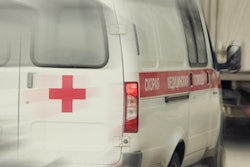
CT mobile stroke units (MSUs) improve patient outcomes and reduce risk of long-term disability, according to research presented March 17 at the virtual International Stroke Conference.
The findings could benefit patients by prompting an increase in the number of mobile stroke units in the field, study lead Dr. May Nour of the University of California, Los Angeles (UCLA) said in a statement released by the university.
"The study results demonstrate that for every 100 patients treated with a mobile stroke unit rather than standard care later in the emergency department, 27 will have less final disability, including 11 more who will be disability free," she said. "[We] are hopeful that this data provides initiative for expanding the mobile stroke unit pilot in our county to include a fleet of MSUs to serve all of the citizens of Los Angeles County in their greatest time of need."
The adage "time lost is brain lost" is true when it comes to stroke, according to Nour.
"Stroke is one of the golden-hour emergencies in which the swift timing of conclusive diagnosis and treatment dramatically impacts patient outcome and their chances of meaningful recovery," she said.
UCLA's Mobile Stroke Unit is a shared resource of Los Angeles County emergency medical services provider agencies. It launched in 2017 and offers services six days per week, 12 hours per day, delivering patients to 15 stroke center facilities in the county. The unit consists of a CT scanner sited in an ambulance that can image the brain and blood vessels; the vehicle is staffed by a vascular neurologist, a paramedic, a critical care nurse, and a CT technologist.
The onboard CT enables patients to be scanned while en route to the hospital, and brain images can help personnel determine how to manage the stroke, such as through administration of tissue plasminogen activator (tPA) drugs to break up clots. Without an onboard CT scanner, patients have to wait until they reach the hospital to be scanned.
UCLA's mobile stroke program was one of seven across the U.S. to participate in a clinical trial, the results of which were presented at the International Stroke Conference. The study compared results from patients eligible for tPA treatment who were managed by mobile stroke units and compared their outcomes with individuals who received standard ambulance/emergency room care.
Of a total of 1,517 patients with suspected acute ischemic stroke, 617 were managed by a mobile stroke unit and 430 by standard care; of those patients who were eligible for treatment with tPA, 97% received it in a mobile stroke unit and 80% in a standard ambulance/emergency room.
The time between onset of stroke symptoms and administration of tPA was shorter in the MSU group compared to the standard care group, at 72 minutes versus 108 minutes. In the mobile stroke unit group, 33% of patients were treated within an hour, compared with 3% of standard care patients.
"This convincing demonstration of the benefits of MSU care will support the incorporation of mobile stroke units into emergency medical systems throughout the country," Dr. Jeffrey Saver, director of the UCLA Comprehensive Stroke and Vascular Neurology Program, said in the university statement.
But is there financial support?
In related research for the conference published March 11 in Stroke, investigators warned that mobile stroke services don't have enough financial support.
"MSUs provide hyperacute diagnosis and treatment in the prehospital setting and are growing in number around the world," noted a team led by Kenneth Reichenbach, program director of the Mobile Stroke Unit at Lehigh Valley Health Network in Allentown, PA. "However, U.S. MSU reimbursement limits program proliferation and increases dependency on grants to support program costs."
Reichenbach and colleagues conducted a survey of the 20 existing mobile stroke unit programs in the U.S., with a 95% response rate. When it came to reimbursement for the service, the group found that, of the 15 programs that billed, 47% billed emergency medical service advanced life support charges. Additional billing included CT (53%), critical care (5%), telemedicine (53%), tPA (21%), and labs (5%).
But billing collection was poor, the group wrote: All of the programs except one described their financial performance as negative and all depended on grants, philanthropy, or institutional support.
"U.S. billing restrictions challenge MSU financial sustainability, limiting reimbursement to traditional EMS ambulance services," Reichenbach's team concluded. "Given the importance of early MSU treatment to reduce disability and death, new financial models are needed to ensure the viability of MSU services."





















